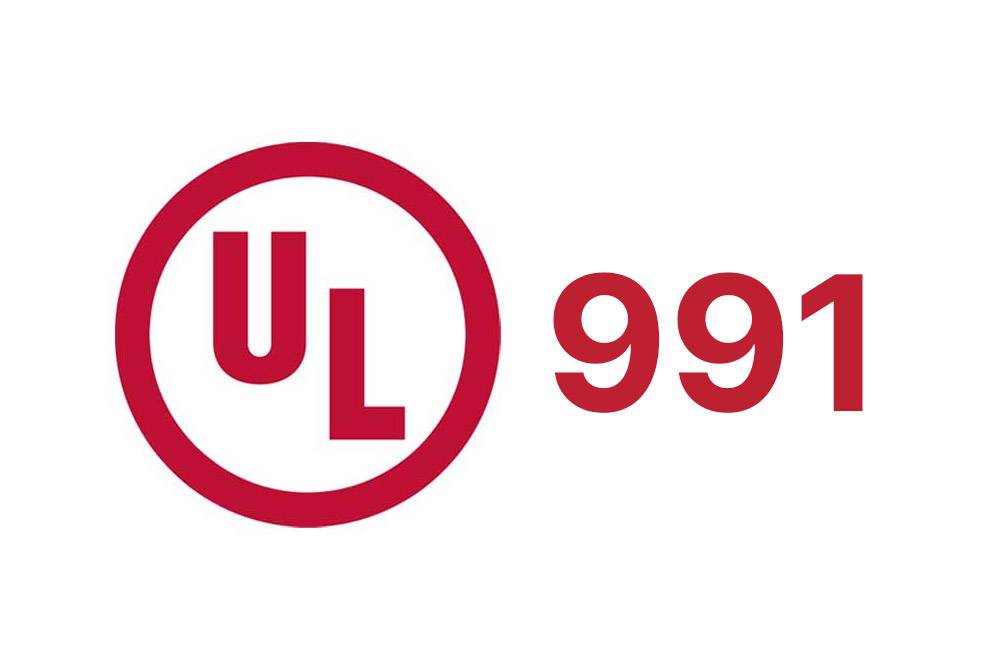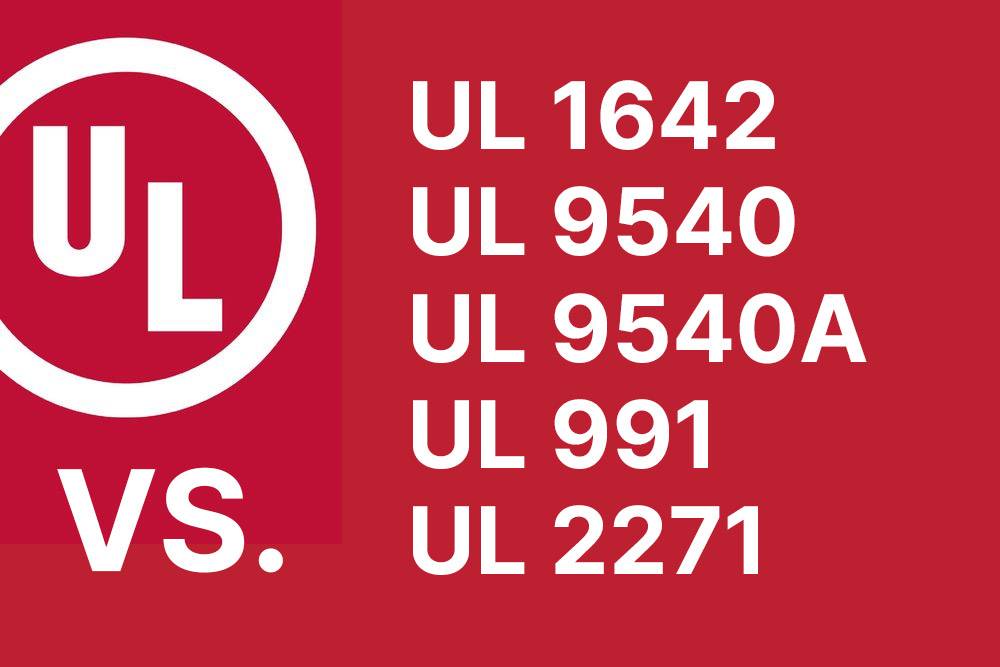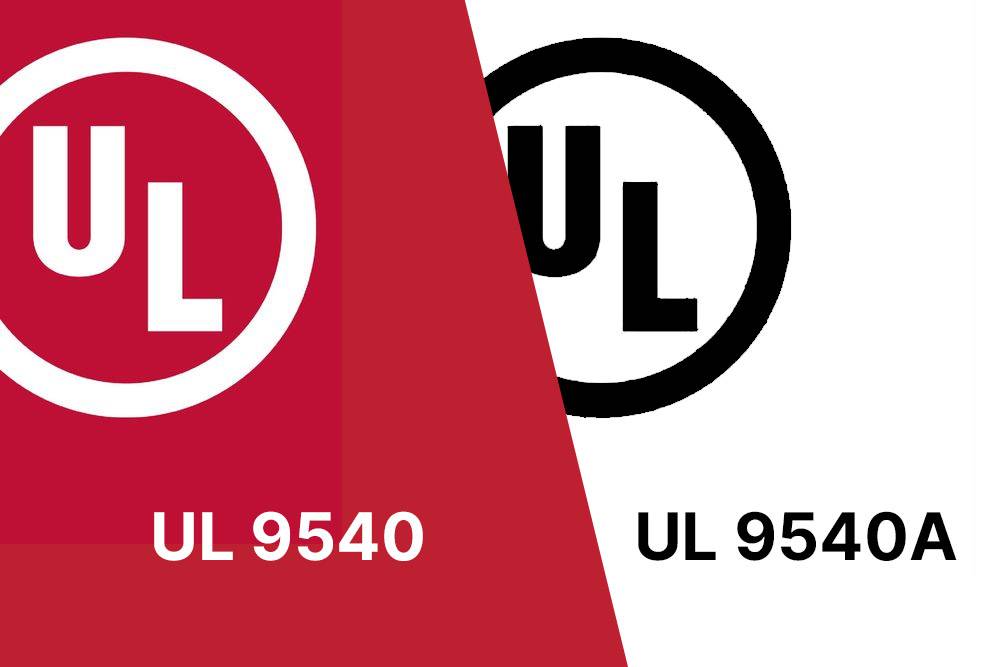UL standards are pivotal in ensuring the safety and performance of various products, notably lithium batteries and Battery Energy Storage Systems (BESS). Developed by Underwriters Laboratories (UL), these standards provide comprehensive guidelines and testing criteria for assessing the safety, reliability, and functionality of these critical systems. In this article, we will delve into five significant UL standards—UL 1642, UL 9540, UL 9540A, UL 991, and UL 2271—and elucidate their importance in the realm of lithium batteries and BESS.
What is UL 1642
UL 1642 serves as a crucial safety standard tailored specifically for Lithium Batteries, encompassing both non-rechargeable (primary) and rechargeable (secondary) variants. Let’s delve into its key aspects:
- Purpose and Scope: UL 1642 addresses the safety concerns surrounding lithium batteries, aiming to mitigate the risks of explosion or fire during battery usage and injury resulting from handling user-replaceable batteries.
- Types of Batteries Covered: The standard applies to various lithium battery configurations, including single electrochemical cells and multiple cells connected in parallel or series. Examples of compliant battery products range from lithium coin cells to long-lasting lithium batteries and LiFePO4 rechargeable batteries.
- Exemptions: UL 1642 does not cover toxicity risks from ingesting battery contents or accessing metallic lithium by cutting open a battery.
- Mandatory Compliance: While UL standards are not inherently mandatory in the United States, regulations may incorporate UL 1642 by reference, rendering compliance obligatory. Regardless, prioritizing product safety, especially for potentially hazardous items like lithium batteries, remains paramount.
In summary, UL 1642 plays a pivotal role in ensuring the safety and reliability of lithium batteries, guiding manufacturers and regulators towards stringent safety standards. By addressing key aspects such as battery types, exemptions, and compliance, UL 1642 provides essential guidelines for mitigating risks associated with lithium battery usage.
What is UL 9540?
UL 9540 is a safety standard specifically developed for Energy Storage Systems (ESS). These systems play a crucial role in addressing challenges related to availability and reliability in today’s energy market. Let’s explore the key aspects of UL 9540:

- Purpose and Importance:
- Energy storage systems, particularly those using battery technologies, help mitigate the variable availability of renewable sources like photovoltaic (PV) or wind power.
- ESS provides reliable power during peak usage times, assists with load management, handles power fluctuations, and performs other grid-related functions.
- As installation codes and standards evolve to address modern energy storage applications, UL 9540 ensures safety by focusing on ESS.
- Requirements and Evolution:
- UL 9540 covers a comprehensive review of ESS, including electrical, electrochemical, mechanical, and other storage technologies.
- Notably, it emphasizes lithium-ion battery installations.
- The standard has evolved over time to meet industry needs and regulatory requirements.
- In its second edition, UL 9540 addresses ESS size and separation requirements.
- Size limits prevent fire propagation between adjacent ESS units, while spacing requirements define minimum separations.
- Exceptions allow larger energy capacities and smaller spacings based on large-scale fire testing conducted according to UL 9540A, the Test Method for Evaluating Thermal Runaway Fire Propagation in Battery Energy Storage Systems.
- Safety Assurance:
- Manufacturers seeking compliance with new regulations can use UL 9540A fire test reports to demonstrate safety.
- UL 9540 ensures that energy storage systems meet stringent safety standards, promoting confidence in their deployment.
In summary, UL 9540 contributes to safer and more reliable energy storage systems, benefiting utility, commercial, industrial, and residential applications.
UL 9540A for lithium batteries
UL 9540A is a crucial safety standard specifically developed for Battery Energy Storage Systems (BESS). Let’s delve into the details:
- Purpose and Importance:
- UL 9540A addresses safety concerns identified by building codes and fire services in the United States.
- One of the primary concerns it tackles is the potential fire and explosion hazards associated with battery systems, such as Uninterrupted Power Supplies (UPS) or battery energy storage systems (BESS).
- The standard aims to ensure the safe operation of BESS by controlling these hazards through stringent limits on energy capacity and separation distances.
- Test Method:
- The UL 9540A Test Method evaluates thermal runaway fire propagation within battery energy storage systems.
- It helps identify potential hazards and vulnerabilities in energy storage systems, enabling manufacturers to make necessary design modifications to improve safety and reduce risks.
- By adhering to this test method, manufacturers can prove compliance with fire safety standards.
- References:
- UL 9540A is referenced within various standards and codes, including:
- UL 9540: The Standard for Energy Storage Systems and Equipment.
- American and Canadian National Standard for Safety for Energy Storage Systems and Equipment.
- International Code Council (ICC) International Fire Code (IFC).
- National Fire Protection Association (NFPA) 855, Standard for the Installation of Stationary Energy Storage Systems.
- Numerous local, state, and international building and fire codes.
- UL 9540A is referenced within various standards and codes, including:
- Safety Journey:
- As energy storage systems become more prevalent, the need for robust safety measures grows.
- UL 9540A helps manufacturers prove compliance with new regulations and ensures the safe adoption of innovative battery technologies.
Remember, safety standards like UL 9540A play a vital role in safeguarding both people and property when it comes to energy storage systems.
UL 9540A: Importance for Lithium Battery Importers and Manufacturers
As a lithium battery importer or manufacturer, understanding UL 9540A is crucial for ensuring compliance, product safety, and market acceptance. Introducing the importance of UL 9540A for lithium battery importers and manufacturers, this breakdown underscores its critical role in ensuring compliance, safety, and market acceptance. By adhering to these standards, businesses can mitigate risks, enhance product quality, and build trust with customers and stakeholders. UL 9540A serves as a comprehensive framework, guiding industry players towards safety and reliability in the increasingly vital sector of Battery Energy Storage Systems (BESS).
- Compliance Assurance: UL 9540A extends safety standards beyond UL 9540, focusing on internal component safety and fault response capabilities specific to Battery Energy Storage Systems (BESS). Compliance with these standards demonstrates your commitment to meeting stringent safety requirements, which is essential for regulatory compliance and market access.
- Risk Mitigation: UL 9540A introduces rigorous testing protocols to evaluate thermal runaway propagation within BESS. This emphasis on risk mitigation is critical for lithium battery importers and manufacturers as it helps identify potential hazards and ensures the resilience of BESS components under fault conditions. By adhering to UL 9540A standards, you can mitigate risks associated with thermal runaway and enhance product safety.
- Quality Assurance: Adhering to UL 9540A standards signifies a dedication to quality assurance and reliable performance. For importers and manufacturers, this assurance is invaluable as it helps build trust with customers and stakeholders. Meeting UL 9540A requirements demonstrates that your lithium battery products are capable of withstanding demanding applications and delivering consistent performance over time.
- Market Acceptance: Compliance with UL 9540A can enhance market acceptance and competitiveness. Many customers, especially in industries such as renewable energy, electric vehicles, and grid storage, prioritize safety and reliability when choosing lithium battery products. By meeting UL 9540A standards, you can differentiate your products in the market and appeal to customers seeking high-quality, compliant solutions.
- Reduced Liability: Ensuring compliance with UL 9540A can help mitigate liability risks associated with product safety incidents. By proactively implementing safety measures and meeting industry standards, importers and manufacturers can minimize the risk of costly recalls, lawsuits, and reputational damage.
Overall, UL 9540A is not just a set of standards; it’s a framework that helps importers and manufacturers prioritize safety, quality, and reliability in their lithium battery products. By understanding and adhering to UL 9540A requirements, you can navigate regulatory complexities, mitigate risks, and position your products for success in the market.
UL 9540 vs UL 9540A, What are the Key Differences?
While UL 9540 and UL 9540A share the overarching goal of enhancing the safety of energy storage systems (ESS), they diverge in scope and focus:
- UL 9540: Primarily focuses on establishing safety guidelines for integrating and operating BESS. It addresses aspects such as installation, operation, and maintenance, ensuring the safe deployment of energy storage systems.
- UL 9540A: Places greater emphasis on internal component safety and fault response capabilities within BESS. It introduces rigorous testing protocols to evaluate the resilience of BESS components under fault conditions, enhancing overall system safety and reliability.
Both standards play crucial roles in mitigating ESS risks, facilitating their safe deployment across diverse applications. For a detailed comparison between UL 9540 and UL 9540A, please refer to: UL 9540 vs UL 9540A, What are the Differences?
UL 991 for lithium batteries
UL 991 is a critical safety standard governing control systems utilizing solid-state devices. Designed to ensure their safe operation, UL 991 covers a wide array of applications, from industrial machinery to consumer electronics.
Key aspects of UL 991 include comprehensive testing and certification procedures conducted by Underwriters Laboratories (UL) to verify compliance with safety requirements. The standard encompasses various solid-state components, including transistors, diodes, and integrated circuits, assessing their performance under diverse conditions to mitigate risks such as electrical hazards and overheating.
In essence, UL 991 provides essential guidelines for manufacturers to design, test, and operate control systems incorporating solid-state components, promoting safety across multiple applications.

UL 2271 for lithium batteries
UL 2271 is a pivotal standard specifically crafted for ensuring the safety of lithium-ion batteries utilized in Light Electric Vehicles (LEVs). Released by Underwriters Laboratories (UL), a renowned global safety science organization, in December 2016, this standard sets forth stringent requirements to safeguard against the unique hazards associated with lithium-ion batteries in LEVs.
Key Aspects Covered by UL 2271:
- Design Requirements: UL 2271 outlines comprehensive safety criteria pertaining to the design of lithium-ion batteries utilized in LEVs. This encompasses aspects such as cell configuration, housing, and overall construction, ensuring robustness and reliability in operation.
- Manufacturing Guidelines: The standard provides meticulous guidelines for the manufacturing process of these batteries. Manufacturers are required to adhere to specific quality control measures to uphold safety standards throughout the production cycle.
- Testing Procedures: UL 2271 delineates rigorous testing protocols aimed at evaluating the safety and performance of lithium-ion batteries. These tests rigorously assess factors such as thermal stability, electrical performance, and resistance to mechanical stress, ensuring adherence to stringent safety benchmarks.
- Risk Mitigation: Compliance with UL 2271 enables manufacturers to effectively mitigate risks associated with battery failures, thermal runaway, and other safety hazards. By adhering to these rigorous standards, manufacturers can instill confidence in the reliability and safety of lithium-ion battery packs used in LEVs.
In summary, UL 2271 certification is paramount for all lithium-ion battery packs intended for LEV applications in the United States. This certification ensures that these batteries meet stringent safety requirements, thereby bolstering confidence in their reliability and performance on the road.
Comparison and Conclusion
In summary, UL 1642, UL 9540, UL 9540A, UL 991, and UL 2271 are pivotal standards for ensuring the safety and performance of lithium batteries and BESS across diverse applications. Each standard addresses specific focus areas and testing criteria, collectively contributing to the advancement of clean energy technologies and sustainable development initiatives. By adhering to these standards, manufacturers can ensure the safety, reliability, and functionality of lithium batteries and BESS, thereby fostering the widespread adoption of clean energy solutions.
FAQs
Is UL1642 mandatory?
This answer accurately states that UL certification is voluntary in the United States and focuses on product safety performance, excluding EMC characteristics. It correctly emphasizes that UL certification is not compulsory but is often sought to demonstrate product safety.
What’s the UL1642 standard for lithium-ion batteries?
UL 1642 is a vital safety standard for lithium-ion batteries. Developed by Underwriters Laboratories (UL), it ensures that lithium-ion batteries meet rigorous safety requirements. The standard covers both rechargeable and non-rechargeable lithium batteries used in products. Its main goals are to prevent explosions or fires during battery usage and to ensure safe removal and disposal of user-replaceable lithium batteries. UL 1642 applies to batteries containing metallic lithium, lithium alloy, or lithium ions. Ensuring battery safety is crucial for products prone to explosion, fire, or toxic leaks.
What is the difference between UL 2054 and UL 1642?
The answer effectively highlights the distinction between UL 1642, which is used for testing lithium cells, and UL 2054, which covers battery pack level tests. It provides a clear explanation of the scope of each standard.
Is UL 2054 mandatory?
The answer correctly states that UL2054 is not a mandated test for products shipped into the US but is often required by US end device standards. It could be helpful to specify what constitutes a “severe test” in the context of UL2054.
What is the IEC code for batteries?
The IEC 60086 standard provides an alphanumeric coding system for batteries. It includes letters and numbers to indicate the number of cells, cell chemistry, shape, dimensions, and other important details. This coding system ensures battery interchangeability and benefits both users and device manufacturers. Examples of IEC nomenclature are codes like R20, 4R25X, and CR17345. Following this standard helps ensure compatibility and ease of use for different battery types.
What is the UL1973 standard?
UL 1973 is a safety standard for energy storage systems (ESS). It ensures that manufacturers meet detailed requirements for safety certification. Compliance with UL 1973 is crucial to ensure the safety and reliability of ESS systems. TÜV SÜD provides testing and certification services to support manufacturers in achieving UL 1973 compliance. Protecting personnel and users from potential harm is the main goal of UL 1973.
What is the difference between UL1642 and IEC62133?
UL 1642 and IEC 62133 are standards for the safety of lithium-ion batteries. UL 1642 applies to both primary and secondary batteries, mainly used in the USA. IEC 62133 is internationally accepted and focuses on cell-level safety. It includes additional tests and is fully harmonized with global requirements. Both standards are important, but IEC 62133 offers broader international recognition. Consultation with certification organizations is recommended to determine specific requirements.
What is the difference between UL2054 and UL1642?
UL 2054 is the standard for household and commercial batteries, while UL 1642 specifically addresses lithium batteries (cells). UL 1642 focuses on individual lithium cells, ensuring their safety by testing for hazards like overcharge, overdischarge, short circuits, and temperature changes. UL 2054 applies to small rechargeable battery packs and requires the cells within those packs to be UL 1642 certified. Both standards contribute to battery safety, with UL 2054 building upon UL 1642 for broader applications.
What’s the UL1642 standard for lithium-ion batteries?
UL 1642 is a crucial safety standard for lithium-ion batteries. It ensures they meet rigorous requirements to prevent explosions and fires. Covering both primary and rechargeable batteries, UL 1642 aims to reduce risks during usage and disposal. It applies to batteries containing metallic lithium, lithium alloy, or lithium ions. Ensuring battery safety is essential, especially for products prone to explosion or fire. UL 1642 plays a vital role in safeguarding users and preventing accidents.
What products does UL 1642 cover?
The answer accurately compares UL 1642 and IEC 62133, noting that both are cell-level certifications but IEC 62133 is internationally accepted while UL 1642 is primarily accepted in the USA. It effectively highlights the international acceptance of IEC 62133.
Also Read:
Comparing Lithium-Ion Battery Standards: China, US, EU
UL 9540 vs UL 9540A, What are the Differences?


